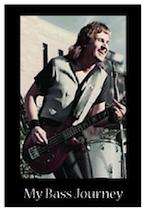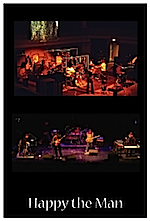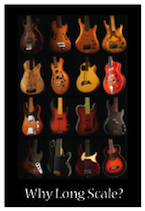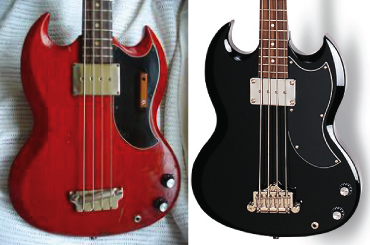MY BASS JOURNEY

   
Please click on any of the photos directly above to proceed to those pages.
THE EARLY DAYS
I grew up in Indiana and I flew through the song flute course in elementary school in record time - and received my "Certificate of Musical Ability". Dad was a jazz guy all the way and was nudging me to play alto sax. As it turns out - I had a terrible sax teacher in school who bullied me and ruined the idea of alto sax for me forever.
After seeing a band at a sock hop in school, I began thinking about playing guitar. I was speaking to a guitar player friend and he said, "Man, you should play bass. If you played bass you could pick any band you wanted in this town - everyone needs a bass player and there aren't many around". True enough. The day my bass and amp arrived, I was instantly in a band. This was the summer of 1964 and when the song "And I Love Her" by the Beatles came out, I was hooked on the beauty and simplicity of that awesome bass line and completely infatuated with the idea of playing bass.
If you are talented, don't ever let learning to play an instrument get in the way of being in a band. You can learn on the fly at rehearsal and my guitar players were very gracious about showing me songs and parts and licks and finger exercises to get me started. I was a quick learner and after all, they wanted a bass player - and they were more than happy to invest the time it took to get me up to speed. I took to the bass like a fish takes to water and spent countless hours wood shedding and learning to play.
Like most budding musicians, I moved from band to band always learning. There was "The Fulcrums", "The Rubber Band", "The Second Society", "Gritt", "Zelda", "Montolith" and probably a few others whose names I don't recall. Talk about supportive - my grandmother was a seamstress and she would "peg" my jeans, buy me boots and put together matching shirts for the early bands I was in.
MY FIRST BASS - "OLD KRAFTSMAN" BY KAY
As a budding twelve year old bassist to be - I cut my teeth on a short scale bass that my father bought me out of the Spiegel catalog. The bass was made by Kay under the name "Old Kraftsman" and was packaged with a bass amp. I had a little money saved, but my father was very supportive - and he had to save for several months to help me with the $179. price tag. As a side note, later on I saved my money for a Fender Bassman, and my Dad and I reupholstered that Spiegel catalog amplifier with silver metal flake pleated naugahyde (think Kustom) and a new black speaker grille. This covered up all the dings and chips, and we sold it for $200. It still sounded fine and it looked amazing. Below is photo of an Old Kraftsman, the same model as mine.
MY KALAMAZOO BASS
As things progressed, I discovered a short scale Kalamazoo bass that my guitarist at the time, Jay Harker owned. The body material was not specified in Kalamazoo literature, but was a wood-laminate produced by a toilet-seat manufacturer in Wisconsin. Mine was "Glacier White" which sure enough looked to be the same color and material as a toilet seat. Maybe this was their "natural". The resemblance to the Fender Mustang was pretty uncanny - although Kalamazoo did a small run of a similar model with a very different SG type body shape too. Both were short scale - with a rosewood fingerboard - and featured the EB-0 style humbucker. They also had bolt-on maple necks - something that Gibson up until this point didn't do. That's me playing it in the photo below.
Here is a closer look at the "toilet seat" Kalamazoo bass.
As my fascination with bass tinkering grew - or maybe it was simply that toilet seat color - I had my father paint the body in his shop a loud purple metal flake - and make a custom clear plexiglas pick guard. We painted the electronics underneath in day-glo colors - so that they looked amazing under black lights. In a hurry to get to rehearsal one day, I leaned the bass against the back of the car and loaded my amp in the trunk, forgetting about the bass. Long story short, I backed over the neck of this guitar with the rear wheel of my car. The case was completely destroyed but the bass was perfect and still in tune!
Here is one of my first bands "The Second Society" rehearsing at Kennell Bros. Body Shop and Garage.
From Left to Right: Dave Mills on guitar, Kevin Jackson on drums, Rick Kennell on bass, Steve Aldred on keys and Jay Harker on guitar.
MY GIBSON EB-0 BASS
I used the Kalamazoo bass for a few years, but eventually I saved a little money and I wanted to move up to the Gibson name and get something more rockin'. I found a used and abused Gibson EB-0 bass for sale cheap - which was short scale at the time. There were lots of serious chips and dings and stickers and decals - and my Dad filled the holes, removed the stickers, sanded it down, and cleaned it up. He sprayed it at his shop a mean gloss black to restore it to perfection. I guess I never have been a "relic" guy, I love to strive for perfection in the instruments I play. I have worked my ass off for everything I have in life and I take extraordinary care of my instruments - as I believe we all should. I think a bass needs to look as good as it sounds in order to provide the full effect of the inspiration.
 |
That is an original 60's Gibson on the left like mine, and a modern day Epiphone on the right - you can see the subtle differences in the models, starting with the bridge and the pick guard. A local bass player friend, Craig Schertz, was a cutting edge electronics guru, and he helped me get the sound of the EB-0 up to par. Craig went on to work at Showco and for years was the house mix engineer for Genesis, ZZ Top, REO Speedwagon, Little Feat, The Carpenters and many others. He also engineered most of the "live" records Genesis released.
Craig installed a switchable capacitor which boosted the mid range of the bass considerably. I then used a wah-wah pedal locked in the down position to add even more mids and highs. I found that the boost to the mids and highs was the kind you couldn't get with EQ alone, and it allowed me to keep the amp settings pretty flat and still cut through the mix. Below is a shot of me playing it.
And a photo of an after football game show at Aldersgate Methodist Church in Fort Wayne.
From Left to Right: Dave Cox on keys, Rick Kennell on bass, Mike Beck on drums, Cliff Fortney on vocals and Jeff Brown on guitar.
THE FORT WAYNE MAFIA
My friend Wil Shape - the guitarist of a very popular Fort Wayne band, "Ethos" - was fortunate to eventually score a deal for his band with Capital Records. Originally they were "The Herd" and then "Atlantis". I used to see them perform on a regular basis and they were the undisputed #1 band in town. They had a huge professional influence on me and they toured the midwest, opening for a slew of national acts. They had a motor home, their own truck, a P.A. and lighting system - and a full crew; it was so inspiring at the time. During my army days, I went to London for Wil and picked up an expensive mixing console they had custom built for the band. As a favor to the them - I navigated the customs and shipping process and shipped it to Fort Wayne from Germany - saving them a few bucks.
Dan Owen, another "Happy the Man" member - was the bassist and singer for "Atlantis" and was also a major influence early on. I still think that Dan has the best singing voice I have ever been in a room with. However, Dan did not record with Ethos but left shortly before they were signed. After Dan left Ethos, Wil told me I was definitely the #1 candidate to take over - but due to Dan's singing voice, they really needed to replace him with a bass player that also had strong lead vocal ability. That left me out.
After his playing days were over, Wil worked his way up at the world-class sound and production company "Showco" and eventually became president. This was right around the time that Showco was developing and perfecting the "Vari-Lites" concept. During this period, there was Wil and Craig at Showco, and a couple of other world-class audio mixers from the Fort Wayne talent pool. This included former "Ethos" keyboardist Mike Ponczek - who was mixing the likes of Eric Clapton, Paul McCartney, The Who and Toto - and M.L. Procise, the former "Ethos" monitor man - who spent a good deal of his life on the road - and not only mixed the house on the Jackson's "Victory Tour - but also engineered the "live" album that went with it. M.L. is currently the 'Senior Director Of Touring' at ClairGlobal - who bought Showco a number of years ago.
There was also Dale Newman, who landed a gig early on with the Genesis organization, and ended up moving to London and being a key part of their full-time staff. Dale served as Mike Rutherford's tour technician and also assumed the role as caretaker of the Genesis studio compound - a role which he still has to this day. Dan Owen was Dale's partner in a songwriting and performing duo - and joined one of the Genesis tours as Daryl Sturmer's road tech. They soon found themselves opening for Genesis on that tour. As a side note, Dale just retired from the Genesis organization at the end of 2013.
There was also Thom Hansen, or "T.H." a former Ethos crew member who also went on to a successful road tech career at Showco. I am sure there were others, but these were my friends and the ones I knew. This core group of guys were affectionately - but jokingly - referred to as the "Fort Wayne Mafia."
FENDER FRUSTRATION
As the Fender basses grew in popularity, I lusted after a Fender Jazz Bass at the Music Manor in Fort Wayne. After playing a few or at least trying to get around on them, I realized that I couldn't play with my usual chops on the long scale necks. I discovered the Fender Mustang, and it looked and felt a lot like the Kalamazoo I had been used to, but I found the pickups a bit brighter - but they were missing that Gibson low end thump and growl I had been accustomed to. It was frustrating because I really wanted something in between - the Mustang was too cramped and the Jazz bass was too long. I felt that the EB-0 - with the capacitor modification and the wah-wah pedal all the way down - sounded better than the stock Mustang, so I stayed with the EB-0.
FROM "TRUE GRITT" TO "GRITT" TO "ZELDA"
As my musical career started to unfold - I had this concept of putting a band together using players from different schools - so I put together my first professional outfit called "True Gritt". This really increased our gig possibilities and we ended up playing shows at most all the schools - which led to a lot of other engagements. This had an instant impact on our popularity. I was the manager and as it turned out - the booking agent too.
We didn't have strong backing vocals - so we avoided covering a lot of the mainstream bands of the day. I think we gravitated to more obscure music, not just because it was so cool (it was) but because we had the freedom to butcher a song or three along the way - and no one would know the difference. Besides, we reasoned, everyone is sick of hearing the same old songs from the "Hit Parade". In the process, we played up the fact that our repertoire was unique - and that oddity turned out to be contagious.
There was no such thing as "progressive" rock back then - in fact, I am not sure what that means even today. We had eclectic tastes and started doing covers of songs off of obscure albums that we loved. There was "What Would You Do If the Sun Died" by The Flock, "Silly People" by The Litter, "Heart Attack" by Aorta, "I'm Truckin" by Sprit, "Waitin' For the Wind" by Spookytooth, "Bourée" and "Teacher" by Jethro Tull, "The Knife" by Genesis, "Dreams" by the Allman Brothers and "Cottage Cheese" by Crow. Most of these bands were generally unknown in the Midwest at this point. We were also covering bands like Iron Butterfly, The Moody Blues and Procal Harem and we were gaining fans and momentum with every performance. In the end, we prided ourselves on NOT playing the tunes that all the other bands were playing.
We started writing and performing our own material, moody songs with extended harmonic structure and sophisticated instrumental passages. Original songs like "Tortuga", "Stony Vessel" and "Idiosyncratic Balderdash" started appearing on our set list - and our tunes blended seamlessly alongside the obscure cover material we were performing. Our front man, Cliff Fortney, was quite a showman with a powerful voice who also killed on harp and flute. He ended up being the first front man for "Happy the Man."
In the Zelda photo below from Left to Right: Dave Cox, Mike Beck, Rick Kennell, Jeff Brown and Cliff Fortney.
The Monolith photo is Left to Right: Rick Kennell, Brad Smith, Steve Paddock (kneeling), Mike Beck, Ric Heeter and Kim Detwiler.
It was around this time that the John Wayne movie "True Grit" came out and we immediately dropped the True and settled on "Gritt". About a month later we grew so sick of all the questions regarding the name that we changed it to "Zelda". We entered Billboard Magazine's "Search for the New Sound" contest and won the midwestern region. We found out a few months later that we did not reach the National finals in the Billboard competition. The news signaled a sort of defeat and took the wind out of our sails.
MONOLITH
Soon after, due to all the usual reasons - the drummer, Michael Beck and I left "Zelda" and started "Monolith". It was more or less the same concept - but with a whole new batch of top notch guys - and we added a sax player. Monolith was only together for a short time and it would be my last band before heading out to do my stint in the U.S. Army. |